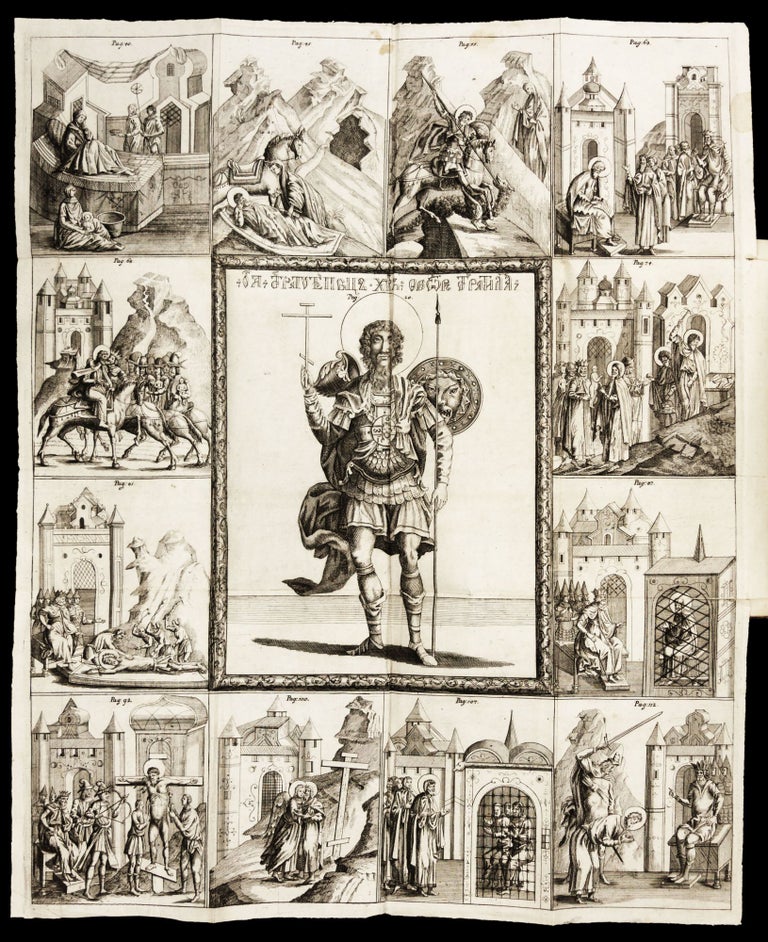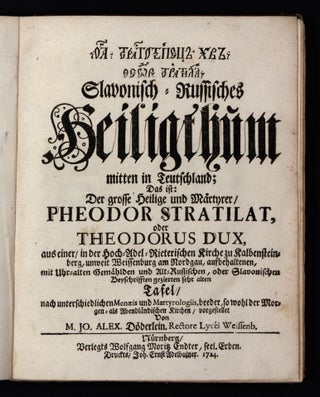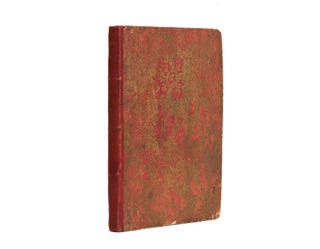Slavonisch-Russisches Heiligthum mitten in Teutschland; Das ist: Der grosse Heilige und Märtyrer, Theodor Stratilat, oder Theodorus Dux….
4to [20.6 x 16.9 cm], 142 pp, (1) f. (errata and note to binder), with (1) large folding engraving [49.5 x 41.2 cm], woodcut initial. Bound in contemporary decorative paper, rebacked in calf; boards covered in red and gold block-printed brocade paper, red sprinkled end papers, red sprinkled pastedowns; some edge wear to covers, rubbing and minor staining to boards, ex libris of Martin Winkler inside upper cover. Folded plate with minor reinforcement along verso of one fold; a few negligible spots. Contents generally excellent. Rare first and only edition of one of the first, if not the first Western monograph devoted to a Russian work of art, namely the icon of the 4th-century warrior saint Theodore Straelates housed in the Rieterkirche St. Marien und Christophorus in Kalbensteinberg, Bavaria, an important pilgrimage church located on the route to Santiago de Compostela. This learned treatise, written by the polymath Johann Alexander Döderlein (1675–1745), Rector of the Lateinschule in Weissenburg, is illustrated with a large folding engraving of the icon – an image of the standing saint surrounded by 12 scenes from his life – which preserves the painting’s exact composition and iconography so that the reader can accurately follow Döderlein’s analysis. Only the painted icon’s (rather minute) inscriptions in Slavonic are omitted from the engraving, but Döderlein supplies these (and gives them close attention) in his printed text. Known as the ‘Franconian treasure-chest,’ the Rieterkirche St. Marien und Christophorus houses several notable artworks, and the Theodore Straelates icon was first displayed there no later than 1613, having perhaps been brought to the region by Philipp Reiter (1566-1635) in the early 17th century after a journey to Russia or Poland (see Lohse, p. 11). At the time of the publication of Döderlein’s monograph in 1724, much art-historical work had been done on style and chronology in Western art, but this Theodore Straelates icon would still have seemed exotic and inscrutable to the average viewer in Bavaria, and such uncertainty about the meaning and origin of Russian icons certainly inspired Döderlein’s scholarly efforts. Long thought to be the work of the Novgorod masters, the icon is now considered to be from the Pskov region (see Lohse, passim), and likely was painted in the first years of the 16th century. On the final leaf of the volume is an interesting note to the bookbinder which neatly demonstrates the difficulties encountered in pairing text with image in publishing early monographic works of art history. Döderlein offers binders three options for placing the large engraving in the book, each of which would maximize the reader’s ability to examine the icon while following Döderlein’s close analysis: The plate could (1) be tipped in at the front in such a manner that when unfolded the book could still be read, or (2) be cut up and each of the sub-scenes of the icon placed at the appropriate spot where they are discussed in Döderlein’s text, or (3) the engraving could be inserted loosely so that the reader might unfold it and place it to the side while reading the book. Döderlein, it appears, cared more about this matter than some bookbinders did, as the present example has the folding engraving tipped in at page 20. reading the first pages of the text. Döderlein also wrote a short account of the icon in Latin, Inscriptiones slavo-russicae tabulae, published in 1724 at Tyrnau (present-day Trnava, Slovakia), but that treatise was unillustrated. OCLC : Getty, Newberry, Harvard, Duke. * H. Lohse, Die Ikone des Hl. Theodor Stratilat zu Kalbensteinberg: Eine Philologisch-Historische Untersuchung.
Sold



